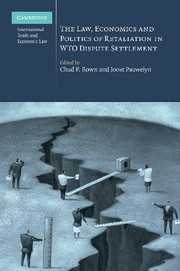Book contents
- Frontmatter
- Contents
- List of tables and figures
- Contributors
- Introduction: trade retaliation in WTO dispute settlement: a multi-disciplinary analysis
- PART I Background and goal(s) of WTO retaliation
- PART II A legal assessment after ten arbitration disputes
- PART III An economic assessment after ten arbitration disputes
- PART IV The domestic politics and procedures for implementing trade retaliation
- 8 The United States' experience and practice in suspending WTO obligations
- 9 The European Community's experience and practice in suspending WTO obligations
- 10 The politics of selecting trade retaliation in the European Community: a view from the floor
- 11 Canada's experience and practice in suspending WTO obligations
- 12 Is retaliation useful? Observations and analysis of Mexico's experience
- 13 Procedures for the design and implementation of trade retaliation in Brazil
- 14 Retaliation in the WTO: the experience of Antigua and Barbuda in US–Gambling
- PART V Problems and options for reform
- PART VI New frontiers and lessons from other fields
- Index
10 - The politics of selecting trade retaliation in the European Community: a view from the floor
Published online by Cambridge University Press: 26 February 2010
- Frontmatter
- Contents
- List of tables and figures
- Contributors
- Introduction: trade retaliation in WTO dispute settlement: a multi-disciplinary analysis
- PART I Background and goal(s) of WTO retaliation
- PART II A legal assessment after ten arbitration disputes
- PART III An economic assessment after ten arbitration disputes
- PART IV The domestic politics and procedures for implementing trade retaliation
- 8 The United States' experience and practice in suspending WTO obligations
- 9 The European Community's experience and practice in suspending WTO obligations
- 10 The politics of selecting trade retaliation in the European Community: a view from the floor
- 11 Canada's experience and practice in suspending WTO obligations
- 12 Is retaliation useful? Observations and analysis of Mexico's experience
- 13 Procedures for the design and implementation of trade retaliation in Brazil
- 14 Retaliation in the WTO: the experience of Antigua and Barbuda in US–Gambling
- PART V Problems and options for reform
- PART VI New frontiers and lessons from other fields
- Index
Summary
Introduction
Since the beginning of the WTO in 1995, the European Community (EC) has taken procedural steps toward trade sanctions in seven trade disputes and introduced sanctions in two cases. The seven cases are reviewed in this volume by Lothar Ehring of the Directorate General for Trade (DG Trade) (Ehring, Chapter 9, above). In my commentary on the politics of selecting and implementing trade sanctions in the EC, I highlight some political and legal problems and suggest an alternative default strategy for the EC.
Splitting the bill
There is no question that as far as the EC is concerned the purpose of trade sanctions is to induce compliance. Other motives suggested in the literature – such as ‘rebalancing’ the exchange of trade concessions after a unilateral breach of the WTO agreement – have no currency in EC trade policy circles. The best strategy to induce compliance is arguably to aim at politically influential sectors and goods made by marginal constituents.
This strategy was used in the US–Steel Safeguards dispute that took aim at ‘swing states’ in the 2004 elections, such as steel from Pennsylvania and orange juice from Florida. While all member states would seem to agree with this strategy in the abstract, splitting the bill has been more problematic because of domestic opposition.
The consultations held in Sweden revealed, for example, a strong opposition to inclusion of orange juice on the product list. The food industry argued that they could not navigate around the sanctions by buying from other sources since brands are based on a certain quality and origin.
- Type
- Chapter
- Information
- Publisher: Cambridge University PressPrint publication year: 2010
- 2
- Cited by

